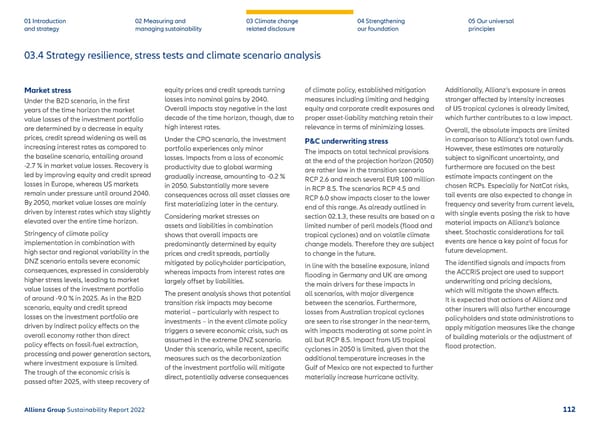03.4 Strategy resilience, stress tests and climate scenario analysis 01 Introduction and strategy 02 Measuring and managing sustainability 03 Climate change related disclosure 04 Strengthening our foundation 05 Our universal principles Market stress Under the B2D scenario, in the first years of the time horizon the market value losses of the investment portfolio are determined by a decrease in equity prices, credit spread widening as well as increasing interest rates as compared to the baseline scenario, entailing around -2.7 % in market value losses. Recovery is led by improving equity and credit spread losses in Europe, whereas US markets remain under pressure until around 2040. By 2050, market value losses are mainly driven by interest rates which stay slightly elevated over the entire time horizon. Stringency of climate policy implementation in combination with high sector and regional variability in the DNZ scenario entails severe economic consequences, expressed in considerably higher stress levels, leading to market value losses of the investment portfolio of around -9.0 % in 2025. As in the B2D scenario, equity and credit spread losses on the investment portfolio are driven by indirect policy effects on the overall economy rather than direct policy effects on fossil-fuel extraction, processing and power generation sectors, where investment exposure is limited. The trough of the economic crisis is passed after 2025, with steep recovery of equity prices and credit spreads turning losses into nominal gains by 2040. Overall impacts stay negative in the last decade of the time horizon, though, due to high interest rates. Under the CPO scenario, the investment portfolio experiences only minor losses. Impacts from a loss of economic productivity due to global warming gradually increase, amounting to -0.2 % in 2050. Substantially more severe consequences across all asset classes are first materializing later in the century. Considering market stresses on assets and liabilities in combination shows that overall impacts are predominantly determined by equity prices and credit spreads, partially mitigated by policyholder participation, whereas impacts from interest rates are largely offset by liabilities. The present analysis shows that potential transition risk impacts may become material – particularly with respect to investments – in the event climate policy triggers a severe economic crisis, such as assumed in the extreme DNZ scenario. Under this scenario, while recent, specific measures such as the decarbonization of the investment portfolio will mitigate direct, potentially adverse consequences of climate policy, established mitigation measures including limiting and hedging equity and corporate credit exposures and proper asset-liability matching retain their relevance in terms of minimizing losses. P&C underwriting stress The impacts on total technical provisions at the end of the projection horizon (2050) are rather low in the transition scenario RCP 2.6 and reach several EUR 100 million in RCP 8.5. The scenarios RCP 4.5 and RCP 6.0 show impacts closer to the lower end of this range. As already outlined in section 02.1.3 , these results are based on a limited number of peril models (flood and tropical cyclones) and on volatile climate change models. Therefore they are subject to change in the future. In line with the baseline exposure, inland flooding in Germany and UK are among the main drivers for these impacts in all scenarios, with major divergence between the scenarios. Furthermore, losses from Australian tropical cyclones are seen to rise stronger in the near-term, with impacts moderating at some point in all but RCP 8.5. Impact from US tropical cyclones in 2050 is limited, given that the additional temperature increases in the Gulf of Mexico are not expected to further materially increase hurricane activity. Additionally, Allianz’s exposure in areas stronger affected by intensity increases of US tropical cyclones is already limited, which further contributes to a low impact. Overall, the absolute impacts are limited in comparison to Allianz’s total own funds. However, these estimates are naturally subject to significant uncertainty, and furthermore are focused on the best estimate impacts contingent on the chosen RCPs. Especially for NatCat risks, tail events are also expected to change in frequency and severity from current levels, with single events posing the risk to have material impacts on Allianz’s balance sheet. Stochastic considerations for tail events are hence a key point of focus for future development. The identified signals and impacts from the ACCRiS project are used to support underwriting and pricing decisions, which will mitigate the shown effects. It is expected that actions of Allianz and other insurers will also further encourage policyholders and state administrations to apply mitigation measures like the change of building materials or the adjustment of flood protection. Allianz Group Sustainability Report 2022 112
 Sustainability Report 2022 | Allianz Page 112 Page 114
Sustainability Report 2022 | Allianz Page 112 Page 114